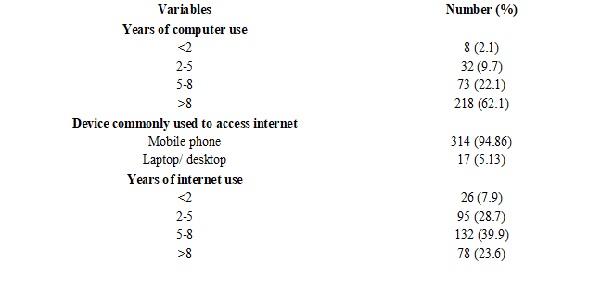A cross sectional study on internet addiction among students of KMCT integrated campus
Abstract
Background: College students are vulnerable for developing dependence on the Internet, more than most other segments of the society. Studies on pathological internet use in India especially Kerala are scanty. So this study was conducted to find out internet addiction among college students.
Objectives: 1) To find out the prevalence of internet addiction among the college students 2) To study the pattern of internet usage among these students.
Methods: This cross-sectional study was carried out in students of four different colleges under KMCT Group of Institutions in Kozhikode, Kerala 2016-17. The data was collected by self- administering questionnaire consisting of socio demographic information, internet usage and Young’s Internet Addiction Test (YIAT). Data collected was entered in Microsoft excel and analyzed using SPSS. Prevalence of internet addiction was determined based on total score of YIAT.
Result: The mean age of the study participants was 20.25±1.3SD. About 48.3% were males and 51.7% females. The mean age of computer use and internet use was 10.01 ± 3.55 years and 6.61 ± 3.13 years respectively. Prevalence of internet addiction was 77.6% in mild users and 18.4% in moderate users. 49.24% accessed internet during night time. 94.86% had internet connection in their smart phones and it was the most common device used for accessing internet. 93.1% said that internet helps in improving their academics. 43.5% visited various sites for more than ten times a month for academic purposes. 14.5% visited various sites on internet when they get time in between lecture classes and 7.1% visited different sites during an ongoing lecture.
Conclusion: The results highlight the vulnerability of professional college students to internet addiction.
Downloads
References
2. Vidyachathoth, Kodavanji B, Kumar NA, Pai SR. Correlation between Affect and Internet Addiction in Undergraduate Medical Students in Mangalore. J Addict Res Ther. 2014 Feb;5(1):1-4. DOI: 10.4172/2155-6105.1000175.
3. Bahrainian SA, Alizadeh KH, Raeisoon MR, et al. Relationship of Internet addiction with self-esteem and depression in university students. J Prev Med Hyg. 2014 Sep;55(3):86-9.[pubmed]
4. Salehi M, Norozi Khalili M, Hojjat SK, et al. Prevalence of internet addiction and associated factors among medical students from Mashhad, Iran in 2013. Iran Red Crescent Med J. 2014 May;16(5):e17256. doi: 10.5812/ircmj.17256. Epub 2014 May 5.[pubmed]
5. Young K. Assessment of internet addiction. Available from: https://gamedependencia.files.wordpress.com/ 2013/06/ young-assessment-of-internet-addiction.pdf.
6. Surwase K, Bagdey P, Adikane H. Prevalence and Associated Risk Factors of Internet Addiction in College Going Students in Nanded city. Natl J Community Med. 2017 May;8(5):213-218.
7. Goel D, Subramanyam A, Kamath R. A study on the prevalence of internet addiction and its association with psychopathology in Indian adolescents. Indian J Psychiatry. 2013 Apr;55(2):140-3. doi: 10.4103/0019-5545.111451.[pubmed]
8. Krishnamurthy S, Chetlapalli SK. Internet addiction: Prevalence and risk factors: A cross-sectional study among college students in Bengaluru, the Silicon Valley of India. Indian J Public Health. 2015 Apr-Jun;59(2):115-21. doi: 10.4103/0019-557X.157531.[pubmed]
9. Sharma KD, Gupta ID, Gunjan, Sharma V, Sharma R, Sharma D. Internet addiction pattern among high school students of Jaipur city: a descriptive study. International Multispeciality Journal of Health. 2016 May;2(5):25-31. Available from: https://imjhealth.org/admin/issues_detail/gallery/IMJH-MAY-2016-6.pdf.
10. Sharma A, Sahu R, Kasar PK, Sharma R. Internet addiction among professional courses students: A study from Central India. Int J Med Sci Public Health. 2014 Jun;3(9):1069-73. DOI:10.5455/ijmsph.2014.180620142.
11. Grover S, Chakraborty K, Basu D. Pattern of Internet use among professionals in India: Critical look at a surprising survey result. Ind Psychiatry J. 2010 Jul;19(2):94-100. doi: 10.4103/0972-6748.90338.[pubmed]
12. Lam LT, Peng ZW, Mai JC, et al. Factors associated with Internet addiction among adolescents. CyberpsycholBehav. 2009 Oct;12(5):551-5. doi: 10.1089/cpb.2009.0036.[pubmed]
13. Chathoth VM, Kodavanji B, Nayanatara AK, Pai SR. Internet behaviour pattern in undergraduate medical students in Mangalore. International Journal of Innovative Research in Science, Engineering and Technology. 2013 Jun;2(6):2133.Available from: http://www.ijirset.com/upload/june/19_INTERNET.pdf.
14. Liu X, Bao Z, Wang Z. Internet Use and Internet Addiction Disorder Among Medical Students: A Case from China. Asian Social Science. 2010 Jan;6(1):28-34. DOI:10.5539/ass.v6n1p28.

Copyright (c) 2019 Author (s). Published by Siddharth Health Research and Social Welfare Society

This work is licensed under a Creative Commons Attribution 4.0 International License.


 OAI - Open Archives Initiative
OAI - Open Archives Initiative


